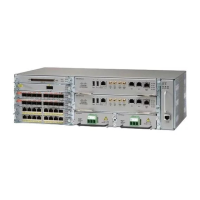23
Cisco IOS XE 3S Release Notes for the Cisco ASR 903 Router
OL-26630-08
Chapter
Caveats in Cisco IOS XE 3.7S Releases
–
The router is configured with a high number of serial interfaces
–
You reset an interface module or reload the router.
Workaround: There is no workaround.
• CSCuc91007
Symptom: A slave clock displays a high 1PPS offset value from the master clock.
Conditions: Occurs after an interface module reset or stateful switchover (SSO) on the master
device.
Workaround: There is no workaround.
• CSCuc95590
Symptom: The router does not automatically upgrade the FPGA software.
Conditions: Occurs when you load a new image while running an older FPGA version.
Workaround: There is no workaround; however the issue has no functional impact.
• CSCuc98185
Symptom: One out of 48 EFPs in a BDI does not receive traffic when running L3 multicast. The
issue does not happen consistently.
Conditions: Occurs under the following conditions:
–
You configure Protocol-Independent Multicast-Sparse Mode (PIM-SM) with a static
rendezvous point (RP).
–
You configure a bridge domain interface (BDI) on the PE2 access side
–
You use the BDI to send IGMP v2 static join messages to a single multicast group
–
You disable IGMP snooping globally.
–
You configure 24 EFPs and map them to a single bridge-domain.
–
You initiate multicast traffic.
–
With multicast traffic enabled, you configure 24 EFPs and map them to the existing
bridge-domain.
One of the 48 EFPs does not receive traffic.
Workaround: Reload the router.
• CSCud01644
Symptom: The active forwarding processor (FP) is on the standby route switch processor (RSP).
Conditions: Occurs when you boot the two RSPs in quick succession and the FP on the standby RSP
becomes active before the FP on the active RSP.
Workaround: Reload the router.
• CSCud07236
Symptoms: The router displays console error messages when reloading.
Conditions: Occurs when you reload the router.
Workaround: There is no workaround; however, the messages have no impact on device.

